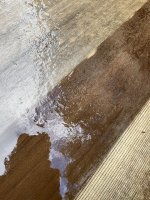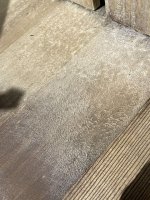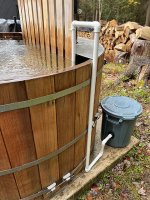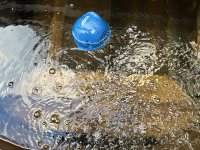Hello everyone. Please forgive what may turn into a long explanation for what might be a simple question(s). Perhaps I should post this in anther topic and not in intros?
I have owned a wood fired cedar hot tub for a little over 3 years. It has no plumbing/filters. It’s from Snorkel and the stove sits inside the tub. It is surprising how little information is out there on how to properly sanitize for this type of hot tub and how much conflicting information there is. Even the company Snorkel doesn't seem to be 100% confident in their suggestions. There exists a lone, long complicated PDF, easily found, which I have read on wood hot tub care. It’s says chlorine is bad (attacks the wood), bromine is good. Snorkel says bromine is bad, chlorine is good. One simple site says just use industrial strength hydrogen peroxide, drain and refill frequently. Non chlorine shock comes up a lot.
There are some inherent challenges I face for sanitizing. We live in the Catskills and we Airbnb our house. We do not let guests use it. It does mean we are away from the tub for stretches. It gets used when we return. We use it for maybe two or three days and then sits for a bit. We have harsh winters and the tub can start to freeze. We can certainly drain and refill it as often as we want. We are in the watershed. We have more water than we know what to do with and it gets filled with very good spring water. The specs of the water are as follows. Very low alkalinity 14, low PH 6.4 and basically no hardness, no metals.
Now my problems may be user error. I'm sure they are. The sole instructions from Snorkel was to use a product called instant ions along with 1” trichlor chlorine tabs in a floater. Basically a mineral and low chlorine sanitize system. Also drain, clean (with a bleach solution) and refill frequently. I am not going to claim I was super on top of balancing the water. I found putting in a cup of baking soda brought my alkalinity and ph up to where they needed to be. I never worried about hardness. I probably should have been more on top of testing for the cooper level from the instant ions and add more instant ions as needed weekly. There are special test strips for this. It was easy to see if the chlorine tabs needed refreshing. I did drain, clean and refill frequently. After reading that long PDF I switched to bromine for a while using the Renew and Refresh products from Leisure Time. I struggled hard with that.
Over time the wood in the tub would start to get slippery and when it was drained it was if there was a slippery film over it. After asking around the general consensus was it was white mold. When the tub would dry out the wood would look frayed. I have now twice let the tub dry out and completely sanded it down and now I’m determined to never have to do that again. I’ve studied and researched and I now know how to balance my water including hardness. Thank you Trouble Free Pool and the Pool Math Calculator!
One of the things I thought may contribute to my problem is the water sits stagnant for long periods. I have recently built a DIY aeration system using pond aerators that I can run 24/7 in an attempt to keep the water moving. I’m hoping this will also help with freezing in the winter. The tub never totally freezes and of course unfreezes as soon as you fire it up.
Meantime during my month of sanding I found the Frog @ease system and I was intrigued. It seemed to present itself as a set it and forget it system once you balance the water. I did a lot of research and read some threads here and I do realize that their system is just clever packaging using readily available supplies and that “smart chlor” is not smart and is just 2000 Flushes with Bleach. Thanks to some threads here it’s clear the data sheets for both products are identical. Side note - people complain at the expense of the “smart chlor" cartridges. I broke one open and measured the amount inside. If you were to buy the same amount of 2000 flushes it would be the same.
I decided to invest in it. A mineral cartridge that lasts 4 months, and a constant supply of “smart chlor.” Along with my DIY aeration system it seemed like it could be the solution for not being with the tub everyday.
Now if you’ve made it this far here is my question. I’ve had quite the back and forth with a rep from Frog who’s been very helpful. I’ve told her the challenges and one thing she mentioned (of course after I bought a round of the @ease system) was that the “smart chlor” will only work when the hot tub is 94 degrees and above. She seemed to suggest that when the water cools down, which it will most of the time, the ‘smart chlor” will cease to sanitize effectively. It will mostly live around 30 degrees and below depending on the time of year. Well that’s a bummer if it’s true. Is it true?
It does seem that the Frog @ease system is just the same system that Snorkel was telling me to do, using instant ions and chlorine tabs. It's just dressed up in fancy packing and much more expensive. It was worth it to me if it meant I didn’t have to worry about being away so much.
If it’s true that “smart chlor” is ineffective a lower water temps would the same hold true for trichlor chlorine tabs? Are the minerals also not effective a lower water temps?
Maybe this is stupid question. If I drained the tub after using it some days and cleaned it and then filled it back up and balanced the water, during the period of non use with cold water would it need to be sanitized? Could I just check that the water is balanced, make adjustments and start sanitizing when I start to use it again. Drain and repeat?
I am open to learning anything that might be helpful in tailoring a solution so I never have to spend a month sanding my hot tub again.
I have owned a wood fired cedar hot tub for a little over 3 years. It has no plumbing/filters. It’s from Snorkel and the stove sits inside the tub. It is surprising how little information is out there on how to properly sanitize for this type of hot tub and how much conflicting information there is. Even the company Snorkel doesn't seem to be 100% confident in their suggestions. There exists a lone, long complicated PDF, easily found, which I have read on wood hot tub care. It’s says chlorine is bad (attacks the wood), bromine is good. Snorkel says bromine is bad, chlorine is good. One simple site says just use industrial strength hydrogen peroxide, drain and refill frequently. Non chlorine shock comes up a lot.
There are some inherent challenges I face for sanitizing. We live in the Catskills and we Airbnb our house. We do not let guests use it. It does mean we are away from the tub for stretches. It gets used when we return. We use it for maybe two or three days and then sits for a bit. We have harsh winters and the tub can start to freeze. We can certainly drain and refill it as often as we want. We are in the watershed. We have more water than we know what to do with and it gets filled with very good spring water. The specs of the water are as follows. Very low alkalinity 14, low PH 6.4 and basically no hardness, no metals.
Now my problems may be user error. I'm sure they are. The sole instructions from Snorkel was to use a product called instant ions along with 1” trichlor chlorine tabs in a floater. Basically a mineral and low chlorine sanitize system. Also drain, clean (with a bleach solution) and refill frequently. I am not going to claim I was super on top of balancing the water. I found putting in a cup of baking soda brought my alkalinity and ph up to where they needed to be. I never worried about hardness. I probably should have been more on top of testing for the cooper level from the instant ions and add more instant ions as needed weekly. There are special test strips for this. It was easy to see if the chlorine tabs needed refreshing. I did drain, clean and refill frequently. After reading that long PDF I switched to bromine for a while using the Renew and Refresh products from Leisure Time. I struggled hard with that.
Over time the wood in the tub would start to get slippery and when it was drained it was if there was a slippery film over it. After asking around the general consensus was it was white mold. When the tub would dry out the wood would look frayed. I have now twice let the tub dry out and completely sanded it down and now I’m determined to never have to do that again. I’ve studied and researched and I now know how to balance my water including hardness. Thank you Trouble Free Pool and the Pool Math Calculator!
One of the things I thought may contribute to my problem is the water sits stagnant for long periods. I have recently built a DIY aeration system using pond aerators that I can run 24/7 in an attempt to keep the water moving. I’m hoping this will also help with freezing in the winter. The tub never totally freezes and of course unfreezes as soon as you fire it up.
Meantime during my month of sanding I found the Frog @ease system and I was intrigued. It seemed to present itself as a set it and forget it system once you balance the water. I did a lot of research and read some threads here and I do realize that their system is just clever packaging using readily available supplies and that “smart chlor” is not smart and is just 2000 Flushes with Bleach. Thanks to some threads here it’s clear the data sheets for both products are identical. Side note - people complain at the expense of the “smart chlor" cartridges. I broke one open and measured the amount inside. If you were to buy the same amount of 2000 flushes it would be the same.
I decided to invest in it. A mineral cartridge that lasts 4 months, and a constant supply of “smart chlor.” Along with my DIY aeration system it seemed like it could be the solution for not being with the tub everyday.
Now if you’ve made it this far here is my question. I’ve had quite the back and forth with a rep from Frog who’s been very helpful. I’ve told her the challenges and one thing she mentioned (of course after I bought a round of the @ease system) was that the “smart chlor” will only work when the hot tub is 94 degrees and above. She seemed to suggest that when the water cools down, which it will most of the time, the ‘smart chlor” will cease to sanitize effectively. It will mostly live around 30 degrees and below depending on the time of year. Well that’s a bummer if it’s true. Is it true?
It does seem that the Frog @ease system is just the same system that Snorkel was telling me to do, using instant ions and chlorine tabs. It's just dressed up in fancy packing and much more expensive. It was worth it to me if it meant I didn’t have to worry about being away so much.
If it’s true that “smart chlor” is ineffective a lower water temps would the same hold true for trichlor chlorine tabs? Are the minerals also not effective a lower water temps?
Maybe this is stupid question. If I drained the tub after using it some days and cleaned it and then filled it back up and balanced the water, during the period of non use with cold water would it need to be sanitized? Could I just check that the water is balanced, make adjustments and start sanitizing when I start to use it again. Drain and repeat?
I am open to learning anything that might be helpful in tailoring a solution so I never have to spend a month sanding my hot tub again.







